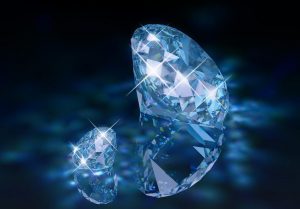Diffusion treatment is divided in two parts:
- Surface Diffusion
- Beryllium Diffusion (also known as Bulk Diffusion)
Surface Diffusion
- Nature of gemstone: This is applied basically on corundum. Experiments are also being conducted on other stones such as topaz.
- Materials used: High temperature furnace along with relevant chemical agents.
- Possible effects: Involves the addition of colour-causing chemicals by diffusing them into the stone by heating. This results in a thin layer of colour at the surface of colourless or light coloured corundum.
- Stones enhanced: Currently this treatment is applied to obtain blue sapphire and ruby, both natural and synthetic.
- Identification:
- Magnification: The most effective means of detecting a diffusion treated stone is its appearance in Methylene Iodide liquid or in glycerin.
- Greater relief, as indicated by a concentration of colour along facet junctions and around the girdle, uneven or patchy facet-to-facet coloration.
- Healed fingerprints, burst halos, melted crystals, partially absorbed and dot like (diffused) silk inclusions are typical.
- Localization, blotchiness of colour (caused by uneven diffusion and repolishing) seen just below the surface or as colour bleeding in surface reaching fractures or cavities.
- Pock marked and burnt surfaces on facets or over the girdle.
- Dense concentration of very small, white inclusions with colour spotting just below the surface and covering entire facets.
- U.V. Lamp: It does not provide diagnostic information for the identification, but some times – weak to moderate, chalky bluish, white to yellowish white under short wave is seen.
- Refractometer: In case of diffusion treated ruby, multiple readings on individual facets and readings over the range are seen.
- Magnification: The most effective means of detecting a diffusion treated stone is its appearance in Methylene Iodide liquid or in glycerin.
- Certification: Such diffusion treated gemstones are certified as per CIBJO rules and regulations.
- Natural sapphire as artificially coloured sapphire
- Natural ruby as artificially coloured corundum
- Synthetic sapphire as artificially coloured sapphire
- Synthetic ruby as artificially coloured corundum
- Procedure: Currently, this treatment is applied to obtain blue sapphire and ruby.
- The colour of corundum is due to transition elements Iron, Chromium, Titanium or Nickel.
- Diffusion treatment first brings the necessary colouring agents (chemicals) into contact with the stone’s surface.
- The stone is then heated to high temperature, causing the lattice structure to expand and allow the energized transition ions to migrate within the surface and hence a thin layer of colour develops around the stone.
- The higher the temperature and longer the time used, the greater the depth of colour penetration.
- Method: To get blue / red colour, commonly colourless or light coloured faceted corundum is embedded in a powder.
- For blue colour this powder consists of a major amount of aluminium oxide, a minor amount of titanium oxide, and lesser amount of iron oxide.
- In case of ruby 3 – 6% of chromium oxide and 22 – 24% titanium oxide is taken in powder form.
- The samples embedded in powder are kept in an alumina crucible. The crucible is then subjected to extend heating in a furnace.
- Conditions:
- Temperature: The elevated temperature ranges from 1600°C to about 1850°C (almost near melting point of corundum).
- At temperatures below 1600°C, the process becomes uneconomically slow and at high temperatures the surface may be damaged.
- Time: Heating time can vary from 2 hours to 200 hours.
- Atmosphere: Oxidizing.
- Results:
- The thickness of the colour layer varies from 0.07mm, (weak colour) to 0.42mm, (deep color) in corundum.
- After this process, the stones become pockmarked, have a burnt and crazed surface and show some melting.
- Light repolishing removes these features.
Beryllium Diffusion
- Nature of gemstone: This is applied basically on corundum.
- Materials used: High temperature furnace along with relevant chemical agents like beryllium, lithium, magnesium, etc.
- Possible effects: Involves the addition of colour-causing chemicals by diffusing them into the stone by heating. This results in a penetration of colouring elements upto the core of the stone.
- Stones enhanced: Initially the treatment performed on pink sapphires to turn into pinkish orange “padparadscha” shade. Now this treatment is being performed on all the colours of corundum to get different fancy shades.
- Causes: The lighter element penetrates into the crystal lattice and takes the position of aluminium, changing the colour. When beryllium enters the crystal of corundum, it imparts yellow color to the stone. When this yellow colour mixes with the pink already present, it gives a pink orange “padparadscha” shade.
- Identification: The identification of these stones is very difficult with the classical instruments or routine tests.
- Like in the case of simple surface diffusion of blue sapphires and rubies, this treatment does not show any colour concentrations on girdle or patchy facets.
- If present, these stones might show an internal colour rim when immersed in bromoform or methylene iodide liquid and viewed in diffused white light.
- The treatment can be detected by a highly sophisticated technique known as LA-ICP-MS stands for Laser Ablation Inductively Coupled Plasma Mass Spectroscopy.
- The other way if one can get features like the characteristic body colour of the stone and inclusions of heat treatment like diffused silk, burst halos, healed fingerprints, then it may be possible to identify.
- Modifications: Both rough and cut gemstones are modified externally to imitate natural gemstones. Such modified materials require careful examination under magnification.
- For e.g. a cheap quality green beryl is surface modified:
- First drilling a hole at the centre.
- A deep green coloured glass is inserted into the hole.
- It is then coated with mud to give appearance of natural rough emerald crystal.
- A synthetic ruby is cut into hexagonal form to imitate red beryl.



























Leave a Reply
You must be logged in to post a comment.